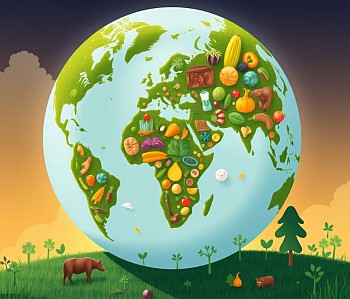nCa-AI Collaborative Report
Executive Summary
Food security remains one of the most pressing global challenges of the 21st century. Despite significant advancements in agricultural productivity and food distribution systems, millions of people worldwide still suffer from hunger and malnutrition. This report examines the current state of global food security, identifies key challenges, and proposes actionable solutions to ensure enough food for all.
Introduction
Food security, as defined by the United Nations, exists when all people, at all times, have physical, social, and economic access to sufficient, safe, and nutritious food that meets their dietary needs and food preferences for an active and healthy life. Despite global efforts, food insecurity persists due to a combination of factors, including poverty, conflict, climate change, and inefficient food systems.
Current State of Global Food Security
Key Statistics
- According to the ‘2023 State of Food Security and Nutrition in the World (SOFI)’ report, over 735 million people faced hunger in 2022, an increase of 122 million since 2019.
- Nearly 2.4 billion people experienced moderate or severe food insecurity in 2022, with women and children disproportionately affected.
- Regions most affected include Sub-Saharan Africa, South Asia, and parts of Latin America and the Caribbean.
Drivers of Food Insecurity
- Conflict and Instability: Wars and political instability disrupt food production and distribution (e.g., Ukraine crisis impacting global grain supplies).
- Climate Change: Extreme weather events, such as droughts, floods, and heatwaves, reduce agricultural yields.
- Economic Inequality: Poverty limits access to food, even when it is available.
- Food Waste: Approximately 1.3 billion tons of food is wasted annually, enough to feed 2 billion people.
- Supply Chain Disruptions: The COVID-19 pandemic and geopolitical tensions have exposed vulnerabilities in global food supply chains.
Challenges to Achieving Food Security
Population Growth
The global population is projected to reach 9.7 billion by 2050, increasing the demand for food by an estimated 50%.
Environmental Degradation
Soil erosion, water scarcity, and deforestation threaten agricultural productivity.
Inequitable Food Distribution
Food is often concentrated in wealthier nations, while poorer regions face shortages.
Rising Food Prices
Inflation and supply chain disruptions have driven up food prices, making it unaffordable for many.
Solutions to Ensure Enough Food for All
Sustainable Agricultural Practices
- Promote ‘regenerative agriculture’ to restore soil health and increase yields.
- Invest in ‘climate-resilient crops’ and farming techniques.
- Encourage ‘agroecology’, which integrates ecological principles into farming.
Reducing Food Waste
- Implement policies to reduce food waste at the production, retail, and consumer levels.
- Educate consumers on proper food storage and meal planning.
Strengthening Food Systems
- Build resilient supply chains to withstand shocks like pandemics and conflicts.
- Support smallholder farmers with access to credit, technology, and markets.
Addressing Inequality
- Expand social safety nets, such as food assistance programs and cash transfers.
- Empower women, who play a critical role in food production and household nutrition.
Leveraging Technology
- Use ‘precision agriculture’ to optimize resource use and increase productivity.
- Develop ‘alternative food sources’, such as lab-grown meat and plant-based proteins.
Global Cooperation
- Strengthen international partnerships to address food insecurity (e.g., the UN’s Sustainable Development Goal 2: Zero Hunger).
- Provide humanitarian aid to conflict-affected regions.
Case Studies
Brazil’s Zero Hunger Program
Brazil’s multi-pronged approach, including cash transfers and support for family farming, reduced hunger by 50% between 2002 and 2013.
Rwanda’s Agricultural Transformation
Rwanda’s focus on land reform, crop diversification, and access to markets has significantly improved food security.
Conclusion
Achieving global food security requires a coordinated effort involving governments, the private sector, civil society, and individuals. By addressing the root causes of hunger, investing in sustainable agriculture, and reducing food waste, we can ensure that everyone has access to sufficient, nutritious food. The time to act is now, as the consequences of inaction will only exacerbate existing inequalities and threaten global stability.
Recommendations
- Governments should prioritize food security in national policies and allocate sufficient funding.
- International organizations must facilitate knowledge sharing and resource mobilization.
- Businesses should adopt sustainable practices and reduce food waste.
- Individuals can contribute by reducing personal food waste and supporting local food systems.
References
- FAO, IFAD, UNICEF, WFP, and WHO. (2023). ‘The State of Food Security and Nutrition in the World 2023’. Rome: FAO.
- United Nations. (2023). ‘Sustainable Development Goals Report 2023’. New York: UN.
- World Bank. (2023). ‘Agriculture and Food’. Washington, DC: World Bank.
This is a two-part series. The second part will look at the profound and tangible connection between food security and peace in the world. /// nCa-AI collaborative, 12 February 2025 [Image credit – Flux.1-schnell]
